Complete Solutions to Exercise of chapter WORK, ENERGY AND POWER of Class 11 book with complete answers and questions
| Class 11 | PHYSICS |
| Chapter | WORK, ENERGY AND POWER |
| PSEB | Exercise |
| Number Of Questions | 48 |
| Academic Year | 2023-24 |
The sign of work done by a force on a body is important to understand. State carefully if the following quantities are positive or negative:- work done by a man in lifting a bucket out of a well by means of a rope tied to the bucket.
02:20View SolutionThe sign of work done by a force on a body is important to understand. State carefully if the following quantities are positive or negative:- work done by friction on a body sliding down an inclined plane.
02:34View SolutionThe sign of work done by a force on a body is important to understand. State carefully if the following quantities are positive or negative:- work done by an applied force on a body moving on a rough horizontal plane with uniform velocity.
02:53View SolutionThe sign of work done by a force on a body is important to understand. State carefully if the following quantities are positive or negative:- work done by the resistive force of air on a vibrating pendulum in bringing it to rest.
02:19View SolutionA body of mass 2 kg initially at rest moves under the action of an applied horizontal force of 7 N on a table with coefficient of kinetic friction = 0.1. Compute the:- work done by the applied force in 10 s.
04:06View SolutionA body of mass 2 kg initially at rest moves under the action of an applied horizontal force of 7 N on a table with coefficient of kinetic friction = 0.1. Compute the:- work done by friction in 10 s.
04:46View SolutionA body of mass 2 kg initially at rest moves under the action of an applied horizontal force of 7 N on a table with coefficient of kinetic friction = 0.1. Compute the:- work done by the net force on the body in 10 s.
04:32View SolutionA body of mass 2 kg initially at rest moves under the action of an applied horizontal force of 7 N on a table with coefficient of kinetic friction = 0.1. Compute the:- change in kinetic energy of the body in 10 s.
03:40View SolutionThe potential energy function for a particle executing linear simple harmonic motion is given by V{x) = `kx^2//2`, wherek is the force constant of the oscillator. For `k = 0.5 N m^-1`, the graph of V[x) versus x is shown in Fig. 6.12. Show that a particle of total energy 1 J moving under this potential must ‘turn back’ when it reaches `x =overset+- 2 m.
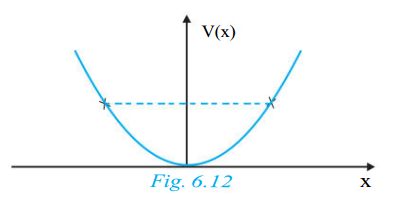 04:05View Solution
04:05View SolutionAnswer the following :- The casing of a rocket in flight burns up due to friction. At whose expense is the heat energy required for burning obtained? The rocket or the atmosphere?
02:16View SolutionAnswer the following :- Comets move around the sun in highly elliptical orbits. The gravitational force on the comet due to the sun is not normal to the comet’s velocity in general. Yet the work done by the gravitational force over every complete orbit of the comet is zero. Why ?
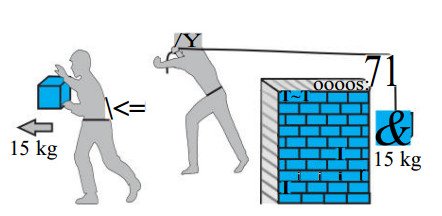 03:02View Solution
03:02View SolutionAnswer the following :- An artificial satellite orbiting the earth in very thin atmosphere loses its energy gradually due to dissipation against atmospheric resistance, however small. Why then does its speed increase progressively as it comes closer and closer to the earth ?
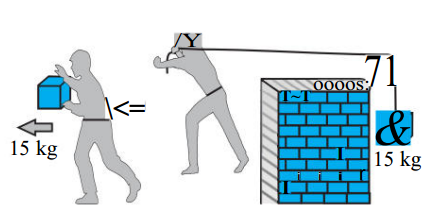 03:48View Solution
03:48View SolutionAnswer the following :- In Fig. 6.13(i) the man walks 2 m carrying a mass of 15 kg on his hands. In Fig. 6.13(ii), he walks the same distance pulling the rope behind him. The rope goes over a pulley, and a mass of 15 kg hangs at its other end. In which case is the work done greater ?
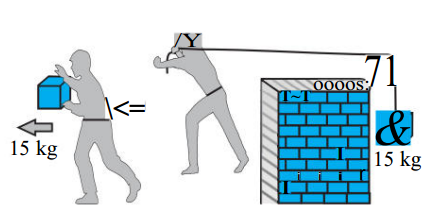 05:29View Solution
05:29View SolutionUnderline the correct alternative :- When a conservative force does positive work on a body, the potential energy of the body `increases//decreases//remains unaltered`.
03:43View SolutionUnderline the correct alternative :- Work done by a body against friction always results in a loss of its kinetic`//`potential energy.
01:29View SolutionUnderline the correct alternative :- The rate of change of total momentum of a many-particle system is proportional to the external force`//`sum of the internal forces on the system.
01:47View SolutionUnderline the correct alternative :- In an inelastic collision of two bodies, the quantities which do not change after the collision are the total kinetic `energy//total linear momentum//total energy` of the system of two bodies.
02:29View SolutionState if each of the following statements is true or false. Give reasons for your answer:- In an elastic collision of two bodies, the momentum and energy of each body is conserved.
02:08View SolutionState if each of the following statements is true or false. Give reasons for your answer:- Total energy of a system is always conserved, no matter what internal and external forces on the body are present.
01:58View SolutionState if each of the following statements is true or false. Give reasons for your answer:- Work done in the motion of a body over a closed loop is zero for every force in nature.
02:18View SolutionState if each of the following statements is true or false. Give reasons for your answer:- In an inelastic collision, the final kinetic energy is always less than the initial kinetic energy of the system.
01:55View SolutionAnswer carefully, with reasons :-In an elastic collision of two billiard balls, is the total kinetic energy conserved during the short time of collision of the balls (i.e. when they are in contact) ?
02:34View SolutionState if each of the following statements is true or false. Give reasons for your answer:- In an elastic collision of two bodies, the momentum and energy of each body is conserved.
02:08View SolutionState if each of the following statements is true or false. Give reasons for your answer:- In an elastic collision of two bodies, the momentum and energy of each body is conserved.
02:08View SolutionA body is initially at rest. It undergoes one-dimensional motion with constant acceleration. The power delivered to it at time t is proportional to
02:46View SolutionA body is moving unidirectionally under the influence of a source of constant power. Its displacement in time tis proportional to
03:00View SolutionA body constrained to move along the z-axis of a coordinate system is subject to a constant force F given by `F=-hati+2hatj+3hatkN` where `hati, hatj, hatk` are unit vectors along the x-, y- and z-axis of the system respectively. What is the work done by this force in moving the body a distance of 4 m along the z-axis ?
01:12View SolutionAn electron and a proton are detected in a cosmic ray experiment, the first with kinetic energy 10 keV, and the second with 100 keV. Which is faster, the electron or the proton ? Obtain the ratio of their speeds, (electron mass = `9.11xx10^-31 kg`, proton mass = `1.67xxl0^-27kg`, `1 eV = 1.60 xx 10^-19 J`)
03:19View SolutionA rain drop of radius 2 mm falls from a height of 500 nr above the ground. It falls with decreasing acceleration (due to viscous resistance of the air) until at half its original height, it attains its maximum (terminal) speed, and moves with uniform speed thereafter. What is the work done by the gravitational force on the drop in the first and second half of its journey ? What is the work done by the resistive force in the entire journey if its speed on reaching the ground is `10 m s^-1` ?
03:32View SolutionA molecule in a gas container hits a horizontal wall with speed 200 m s_1 and angle `30^@` with the normal, and rebounds with the same speed. Is momentum conserved in the collision ? Is the collision elastic or inelastic ?
02:55View SolutionA pump on the ground floor of a building can pump up water to fill a tank of volume `30 m^3` in 15 min. If the tank is 40 m above the ground, and the efficiency of the pump is 30%, how much electric power is consumed by the pump ?
02:56View SolutionTwo identical ball bearings in contact with each other and resting on a frictionless table are hit head-on by another ball bearing of the same mass moving initially with a speed V. If the collision is elastic, which of the following (Fig. 6.14) is a possible result after collision ?
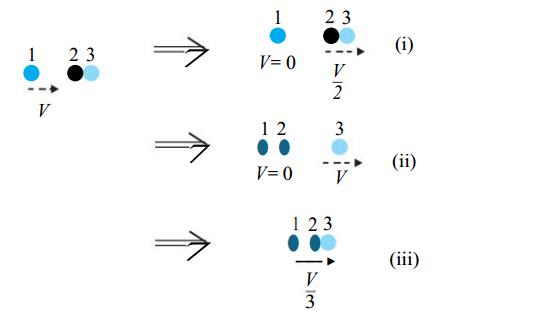 06:05View Solution
06:05View SolutionThe bob A of a pendulum released from `30^@` to the vertical hits another bob B of the same mass at rest on a table as shown in Fig. 6.15. How high does the bob A rise after the collision ? Neglect the size of the bobs and assume the collision to be elastic.
 01:27View Solution
01:27View SolutionThe bob of a pendulum is released from a horizontal position. If the length of the pendulum is 1.5 m, what is the speed with which the bob arrives at the lowermost point, given that it dissipated 5% of its initial energy against air resistance ?
04:24View SolutionA trolley of mass 300 kg carrying a sandbag of 25 kg is moving uniformly with a speed of `27 km//h` on a frictionless track. After a while, sand starts leaking out of a hole on the floor of the trolley at the rate of `0.05 kg s^-1`. What is the speed of the trolley after the entire sand bag is empty ?
02:49View SolutionA body of mass 0.5 kg travels in a straight line with velocity `v=a x(3/2)` where `a=5 m(1/2)s^-1`. What is the work done by the net force during its displacement from x = 0 to x = 2 m?
01:54View SolutionThe blades of a windmill sweep out a circle of area:- If the wind flows at a velocity v perpendicular to the circle, what is the mass of the air passing through it in time t ?
02:28View SolutionThe blades of a windmill sweep out a circle of area :-What is the kinetic energy of the air ?
02:05View SolutionThe blades of a windmill sweep out a circle of area :- Assume that the windmill converts 25% of the wind’s energy into electrical energy, and that A = `30 m^2, v = 36 km//h` and the density of air is `1.2 kg ,m^-3`. What is the electrical power produced ?
08:51View SolutionA person trying to lose weight (dieter) lifts a 10 kg mass, one thousand times, to a height of 0.5 m each time. Assume that the potential energy lost each time she lowers the massis dissipated:- How much work does she do against thegravitational force ?
01:38View SolutionA person trying to lose weight (dieter) lifts a 10 kg mass, one thousand times, to a height of 0.5 m each time. Assume that the potential energy lost each time she lowers the massis dissipated:- Fat supplies `3.8 xx 10^7J` of energy per kilogram which is converted to mechanical energy with a 20% efficiency rate. How much fat will the dieter use up?
06:56View SolutionA family uses 8 kW of power:- Direct solar energy is incident on the horizontal surface at an average rate of 200 W per square meter. If 20% of this energy can be converted to useful electrical energy, how large an area is needed to supply 8 kW?
02:50View SolutionA bullet of mass 0.012 kg and horizontal speed `70 m s^-1` strikes a block of wood of mass 0.4 kg and instantly comes to rest with respect to the block. The block is suspended from the ceiling by means of thin wires. Calculate the height to which the block rises. Also, estimate the amount of heat produced in the block.
09:20View SolutionTwo inclined frictionless tracks, one gradual and the other steep meet at A from where two stones are allowed to slide down from rest, one on each track (Fig. 6.16). Will the stones reach the bottom at the same time? Will they reach there with the same speed? Explain. Given `61 = 30^@`, `theta_2 = 60^@`, and h= 10 m, what are the speeds and times taken by the two stones ?
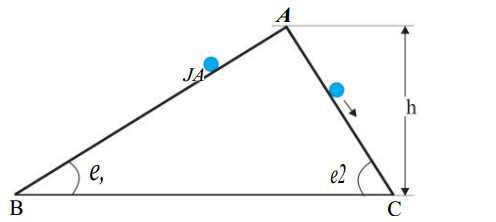 04:54View Solution
04:54View SolutionA 1 kg block situated on a rough incline is connected to a spring of spring constant `100N m^-1` as shown in Fig. 6.17. The block is released from rest with the spring in the unstretched position. The block moves 10 cm down the incline before coming to rest. Find the coefficient of friction between the block and the incline. Assume that the spring has a negligible mass and the pulley is frictionless.
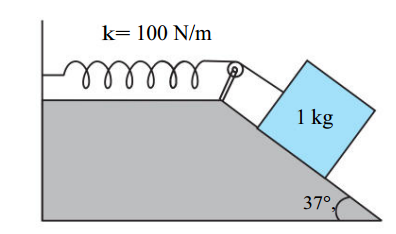 04:54View Solution
04:54View SolutionA bolt of mass 0.3 kg falls from the ceiling of an elevator moving down with an uniform speed of `7 m s^-1`. It hits the floor of the elevator (length of the elevator = 3 m) and does not rebound. What is the heat produced by the impact ? Would your answer be different if the elevator were stationary ?
03:50View SolutionA trolley of mass 200 kg moves with a uniform speed of `36 km//h` on a frictionless track. A child of mass 20 kg runs on the trolley from one end to the other (10 m away) with a speed of `4 m s^-1` relative to the trolley in a direction opposite to the its motion, and jumps out of the trolley. What is the final speed of the trolley ? How much has the trolley moved from the time the child begins to run ?
07:21View SolutionWhich of the following potential energy curves in Fig. 6.18 cannot possibly describe the elastic collision of two billiard balls ? Here r is the distance between centres of the balls.
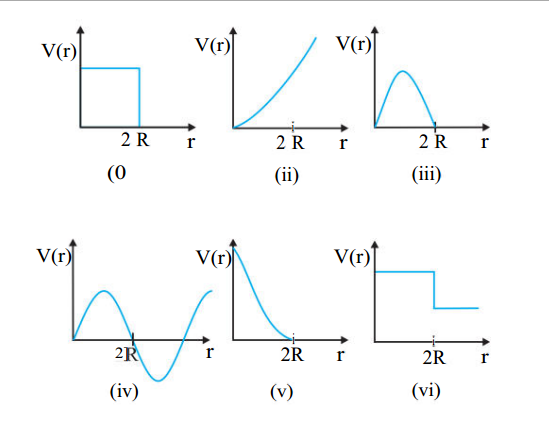 03:02View Solution
03:02View Solution
Exercise questions and complete solutions for chapter WORK, ENERGY AND POWER of PSEB of Class 11
